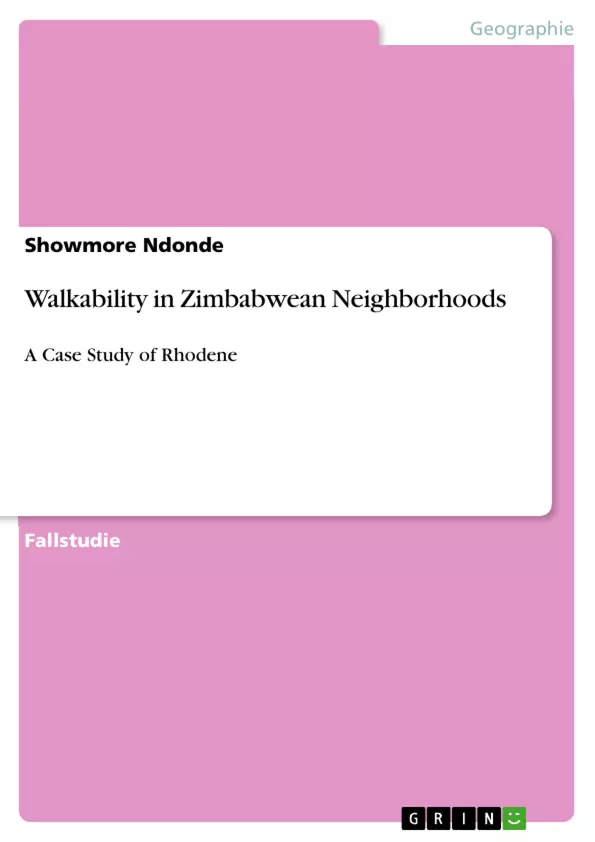The main aim of the study is to investigate the level of walkability of Zimbabwean neighborhoods based on the availability of mixed land uses, safety and aesthetics in Rhodene, Masvingo. Data collection was done through observations, expert based scores from key informants and experiences from residents. The major findings showed that Rhodene was not a walkable neighborhood based on the lack of amenities, safety and aesthetics. In conclusion, the researcher proposed a shift from auto-centric policies to sustainable policies of creating walkable neighborhoods.
Climate change has become a major problem affecting urban environments. The transport sector is a major contributor of climate change through the release of green gases by automobiles. In addressing these issues city planners are advocating for sustainable cities that contain elements of a walkable neighborhood walking. However, the level of walkability in neighborhoods of developing counties remains unclear because of limited knowledge.
Inhaltsverzeichnis
- CHAPTER ONE: INTRODUCTION AND BACKGROUND
- 1.0 Introduction
- 1.1 Background of the Study
- 1.2 Problem Statement
- 1.3 Aim of the Study
- 1.4 Objectives of the Study
- 1.5 Significance of the Study
- 1.6 Theoretical Overview
- 1.7 Methodological Overview
- 1.8 Delineation
- 1.9 Chapter Overview
- 1.10 Conclusion
- CHAPTER TWO: LITERATURE REVIEW
- 2.0 Introduction
- 2.1 Sustainable city
- 2.2 Theoretical Framework
- 2.2.1 Walkability defined
- 2.3 Elements of a walkable neighborhood
- 2.3.1 Safety
- 2.3.2 Availability of mixed land uses
- 2.3.3 Aesthetics/Ambience
- 2.4 Benefits of Walkable Neighborhoods
- 2.4.1 Environmental
- 2.4.2 Economic
Zielsetzung und Themenschwerpunkte
Diese Dissertation befasst sich mit dem Thema der Walkability in zimbabwischen Vierteln, mit einem besonderen Schwerpunkt auf Rhodene, Masvingo. Die Studie zielt darauf ab, die Walkability-Ebene zimbabwischer Viertel anhand der Verfügbarkeit von gemischten Landnutzungen, Sicherheit und Ästhetik zu untersuchen. Die Arbeit untersucht, inwieweit Rhodene die Kriterien für ein begehbares Viertel erfüllt.
- Walkability-Bewertung in zimbabwischen Vierteln
- Die Rolle von gemischten Landnutzungen für die Walkability
- Sicherheitsaspekte in Bezug auf die Walkability
- Der Einfluss von Ästhetik und Ambiente auf die Walkability
- Die Bedeutung von Walkable Neighborhoods für nachhaltige Stadtentwicklung
Zusammenfassung der Kapitel
Kapitel 1 bietet eine Einführung in das Thema der Walkability und stellt die Forschungsfrage und das Ziel der Studie vor. Es beleuchtet den Hintergrund des Problems, die Bedeutung des Themas und die theoretischen und methodischen Ansätze, die verwendet werden. Kapitel 2 befasst sich mit dem aktuellen Forschungsstand zum Thema Walkable Neighborhoods und bietet eine umfassende Literaturrecherche.
Schlüsselwörter
Walkability, nachhaltige Stadtentwicklung, gemischte Landnutzung, Sicherheit, Ästhetik, Rhodene, Masvingo, Zimbabwe, städtische Planung.
- Quote paper
- Showmore Ndonde (Author), 2017, Walkability in Zimbabwean Neighborhoods, Munich, GRIN Verlag, https://www.grin.com/document/960152



